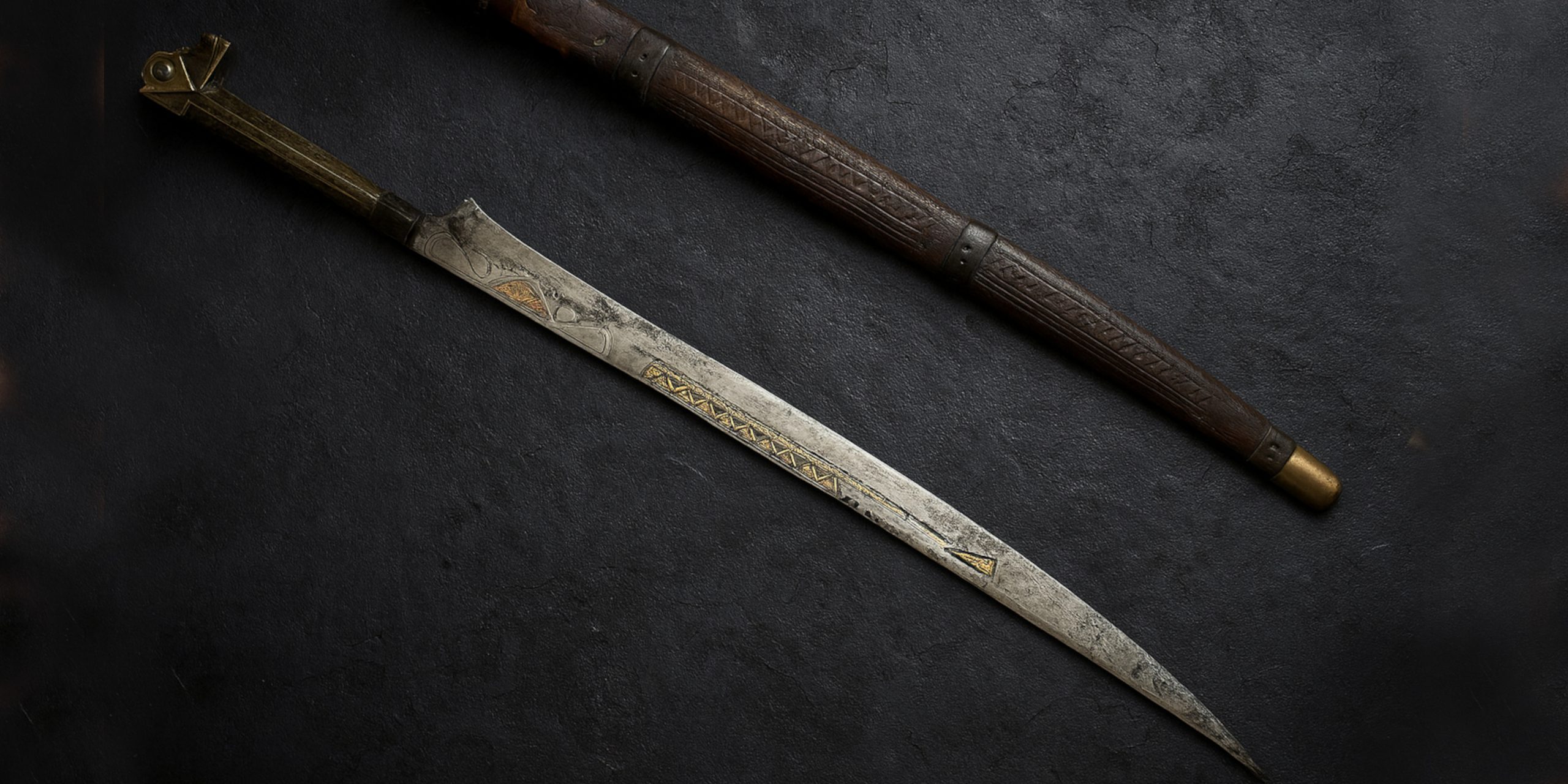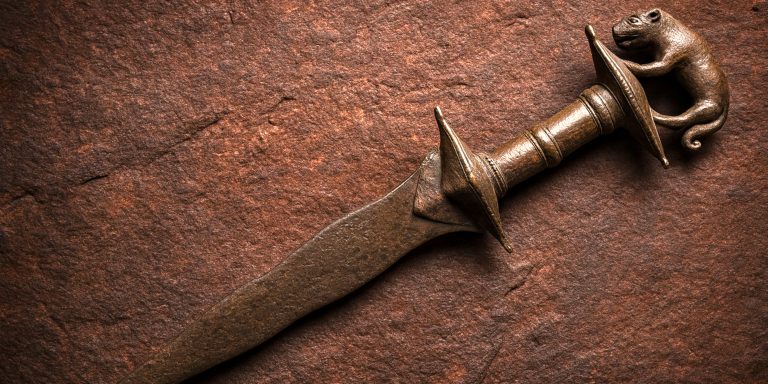
The Flyssa is a distinctive blade from the Kabyle and related Berber communities of northern Algeria. In European collecting circles it is often called a long knife or short sabre. Its profile is unmistakable: a narrow, straight or very slightly concave back, a long clip point that tapers to a needle tip, and a hilt with a stylised horse or bird head pommel carved in the round. Blades can be knife length for belt carry or sword length for martial use, with elaborate chiselled decoration and inlaid brass. The Flyssa sat at the crossroads of indigenous North African craft, Ottoman influence, and Mediterranean trade, which makes it a rewarding subject for historians and collectors alike.
Specification
Typical features for long-knife and short-sabre examples.
| Aspect | Details |
|---|---|
| Origin | Kabyle regions of northern Algeria, 18th to 19th century, with earlier roots |
| Function | Sidearm and status piece; some longer forms served as sabres |
| Overall length | Long knife 40 to 60 cm. Short sabre 70 to 100 cm |
| Blade | Single edged, long clip point, usually flat to shallow lenticular. Often with chiselled panels, geometric motifs, pseudo inscriptions |
| Spine | Straight or very slightly concave with clipped tip, sometimes file-worked |
| Hilt | One-piece grip in wood or horn with metal overlays, or full brass mounts. Zoomorphic pommel head typical |
| Guard | Usually guardless or with small ferrule; some have a short bolster or ears formed by the mounts |
| Sheath | Wood core covered in sheet brass or leather with chased geometric ornament |
| Steel | Wrought iron core with high-carbon edge commonly seen; pattern-welded or crucible steel rare but recorded |
| Weight and balance | Light to moderate weight. Forward tip bias on sabre-length pieces for deep cuts and thrust finish |
History and Evolution
- Origins and cultural context
The form reflects Kabyle aesthetics and technique. Decorative vocabulary draws on Amazigh geometric patterns. Blades show practical battlefield intent and visible status signalling in peacetime. - Influences
Interaction with Ottoman Algeria introduced elements seen across the Maghreb and the Mediterranean. The long clip point and lack of a cross-guard align with local preferences rather than Ottoman guards and quillons. - Chronology
Shorter knife forms are persistent through the 18th and 19th centuries. Longer sabre-length flyssa become more visible in the 19th century, including pieces presented to notables or traded into European markets. - Workshop practice
Regional smiths forged blades locally; some imported bars or recycled steels were used. Chiselling and inlay were separate specialisms, which explains fine decoration on otherwise functional blades.
Advantages and Disadvantages
Strengths
- Excellent penetrative tip geometry for thrusting.
- Long clip gives fine tip control for precise work.
- Narrow blade keeps mass down, making it quick in the hand.
- Guardless grip is compact for carry and draw.
- Decorative brass work resists corrosion better than iron fittings.
Limitations
- Minimal guard gives limited hand protection in blade-on-blade contact.
- Narrow section can lack lateral stiffness in poor-quality examples.
- Wood or horn grips may shrink or crack with age.
- Highly decorated panels can trap moisture if not maintained.
Comparison with Similar Weapons
| Feature | Flyssa (Algeria) | Koummya (Morocco) | Nimcha (Maghreb sabre) | Yatagan (Ottoman) |
|---|---|---|---|---|
| Typical length | Knife to short sabre | Dagger | Full sabre | Short sabre |
| Blade profile | Narrow, long clip point | Recurved dagger blade | Curved sabre with yelman variants | Recurved with pronounced belly |
| Guard | Minimal | Minimal to none | Distinctive downturned guard | None |
| Hilt form | Zoomorphic, one-piece with brass | T-shaped horn with metal overlays | Pierced, often with ball pommel | Ear-shaped grips |
| Primary use | Sidearm and light sabre | Dress and utility dagger | Naval and urban defence sabre | Military sidearm |
| Decorative language | Geometric chiselling, brass inlay | Chased silver, filigree | Mix of local and Ottoman motifs | Inlay and koftgari, less zoomorphic |
Legacy
- Regional identity
The Flyssa has become a visual shorthand for Kabyle craftsmanship. Museum displays often use it to represent Algerian arms in the 18th and 19th centuries. - Collecting and scholarship
European collecting from the mid-19th century onward preserved many fine examples. The variety of decoration and hilt carving continues to attract interest, though documentation of individual workshops remains sparse. - Modern craft
Contemporary artisans in North Africa and Europe create homage pieces. These range from tourist items to serious blades that follow historic construction.
Where to See
- Musée de l’Armée, Paris — holdings of North African arms including flyssa.
- British Museum and Victoria and Albert Museum, London — decorative arts and ethnographic collections with Kabyle work.
- Musée National des Antiquités et des Arts Islamiques, Algiers — regional arms.
- Metropolitan Museum of Art, New York — Islamic and North African arms galleries rotate pieces of similar type.
Check current displays since galleries rotate items.
Collector’s Guide
Variants and Terminology
- Long knife: 40 to 60 cm overall, belt sidearm.
- Short sabre: 70 to 100 cm overall, combat-capable.
- Hilt heads: Stylised horse, bird, or abstract animal; sharper definition and symmetry usually indicate better work.
- Decoration: Chiselled panels, brass dot inlay, file-worked spines, and occasional silver sheet overlays.
What Drives Value
- Blade length and quality of grind and heat-treat.
- Depth and crispness of chiselled motifs.
- Integrity of hilt and scabbard, matching sets preferred.
- Early pieces with refined zoomorphic carving.
- Provenance and published examples.
- Rare metallurgies such as pattern-weld or wootz attributed by testing or clear patterning.
Condition Checklist
- Blade: Look for active corrosion, edge losses, regrinds, or tip reshaping. Original clip profile is a key integrity marker.
- Hilt: Check for cracks or shrinkage in horn or wood. Confirm mounts are original rather than later sheet replacements.
- Fit: Guardless designs still should have a tight bolster area. Any wobble suggests hidden tang issues.
- Scabbard: Wood core should be intact. Brass sheathing often shows work-hardening cracks; light, stable cracks are acceptable.
- Cleaning: Over-polishing erases chiselling. Prefer honest patina.
Legal and Ethical Notes
- Historic ivory elements appear on some 19th-century hilts. Verify legality in your jurisdiction and seek documented pre-Convention status where required. Avoid newly fabricated animal materials.
Care and Preservation
- Light mineral oil on blade, microcrystalline wax on mounts.
- Avoid aggressive polishing. Use cotton swabs to clean chiselled recesses.
- Store in stable humidity. Do not keep blades sealed in leather for long periods.
Auction Prices and Market Ranges
Prices fluctuate by region and provenance. The following bands reflect common outcomes in recent years for authentic pieces in decent condition.
| Category | Typical Range |
|---|---|
| Common long-knife flyssa with moderate decoration | £250 to £600 |
| Better long knives with crisp chiselling and complete scabbards | £600 to £1,200 |
| Short sabre length with quality carving and good steel | £1,200 to £2,500 |
| Exceptional, early, or heavily decorated examples; documented provenance | £2,500 to £6,000+ |
Notes:
- Pairs, unusually long blades, or published examples can exceed these bands.
- Heavy restoration, missing scabbards, or harsh cleaning push items below band.
- Regional sales in North Africa and southern Europe can be softer than London, Paris, or New York rooms.
Quick Identification Table
| Diagnostic | What to Look For |
|---|---|
| Clip point | Long, sharpened clip creating a needle tip |
| Guard | Essentially absent. Small ferrule or bolster only |
| Pommel | Carved animal head or abstract finial integral to the grip |
| Decoration | Geometric chiselling, brass dot inlay, file-worked spine |
| Scabbard | Wood core with brass sheet, often chased with repeating motifs |
Advantages for Study and Display
- Strong regional identity that reads well in a case.
- Variation within a stable type makes for comparative study.
- Often affordable entry point for Islamic and North African arms collections.
Common Pitfalls
- Tourist or revival pieces with shallow machine-like engraving and soft lines.
- Composite scabbards married to blades. Check fit and wear patterns.
- Overly bright metal with buffing marks. Authentic pieces usually show hand tool traces.
The Seven Swords Takeaway
The Algerian Flyssa long knife offers clear lines, purposeful geometry, and rich cultural ornament. It bridges utility and artistry, and it rewards close scrutiny of blade work and chiselling. For collectors, condition and authenticity matter more than lavish decoration alone. For historians, it anchors discussions of Kabyle material culture and North African martial traditions.



